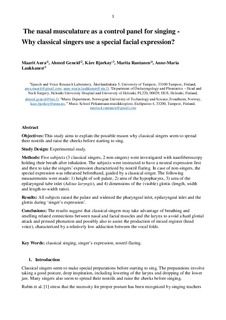| dc.contributor.author | Aura, Maarit | |
| dc.contributor.author | Anne-Maria, Laukkanen | |
| dc.contributor.author | Bjørkøy, Kåre | |
| dc.date.accessioned | 2018-09-06T11:46:41Z | |
| dc.date.available | 2018-09-06T11:46:41Z | |
| dc.date.created | 2017-12-22T09:49:44Z | |
| dc.date.issued | 2017 | |
| dc.identifier.issn | 0892-1997 | |
| dc.identifier.uri | http://hdl.handle.net/11250/2561214 | |
| dc.description.abstract | Objectives
This study aimed to explain the possible reason why classical singers seem to spread their nostrils and raise their cheeks before starting to sing.
Study Design
This is an experimental study.
Methods
Five subjects (three classical singers, two nonsingers) were investigated with nasofiberoscopy holding their breath after inhalation. The subjects were instructed to have a neutral expression first and then to take the singers' expression characterized by nostril flaring. In case of nonsingers, the special expression was rehearsed beforehand, guided by a classical singer. The following measurements were made: (1) height of soft palate, (2) area of the hypopharynx, (3) area of the epilaryngeal tube inlet (Aditus laryngis), and (4) dimensions of the (visible) glottis (length, width, and length-to-width ratio).
Results
All subjects raised the palate and widened the pharyngeal inlet, epilaryngeal inlet, and the glottis during “singer's expression.”
Conclusions
The results suggest that classical singers may take advantage of breathing- and smelling-related connections between nasal and facial muscles and the larynx to avoid a hard glottal attack and pressed phonation and possibly also to assist the production of mixed register (head voice), characterized by a relatively low adduction between the vocal folds. | nb_NO |
| dc.language.iso | eng | nb_NO |
| dc.publisher | Elsevier | nb_NO |
| dc.rights | Attribution-NonCommercial-NoDerivatives 4.0 Internasjonal | * |
| dc.rights.uri | http://creativecommons.org/licenses/by-nc-nd/4.0/deed.no | * |
| dc.title | The Nasal Musculature as a Control Panel for Singing—Why Classical Singers Use a Special Facial Expression? | nb_NO |
| dc.type | Journal article | nb_NO |
| dc.type | Peer reviewed | nb_NO |
| dc.description.version | acceptedVersion | nb_NO |
| dc.source.journal | Journal of Voice | nb_NO |
| dc.identifier.doi | 10.1016/j.jvoice.2017.12.016 | |
| dc.identifier.cristin | 1531348 | |
| dc.description.localcode | © 2018. This is the authors’ accepted and refereed manuscript to the article. Locked until 7.4.2019 due to copyright restrictions. This manuscript version is made available under the CC-BY-NC-ND 4.0 license http://creativecommons.org/licenses/by-nc-nd/4.0/ | nb_NO |
| cristin.unitcode | 194,62,45,0 | |
| cristin.unitname | Institutt for musikk | |
| cristin.ispublished | false | |
| cristin.fulltext | postprint | |
| cristin.qualitycode | 1 | |

